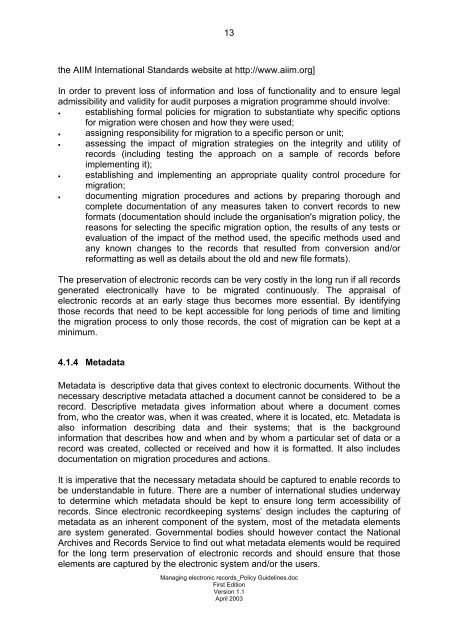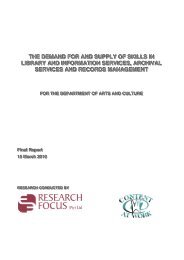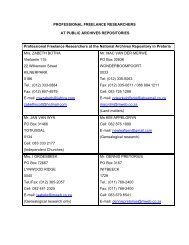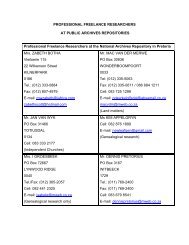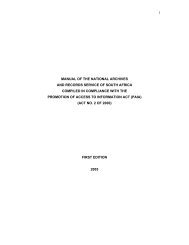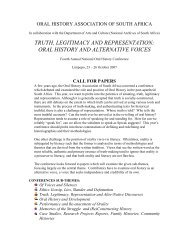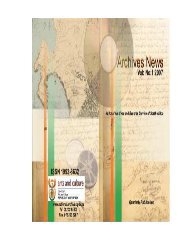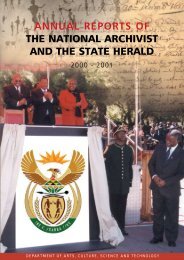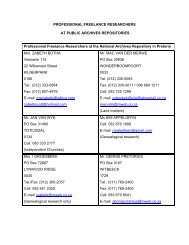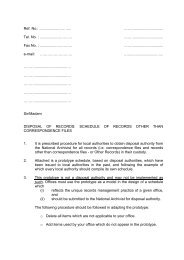managing electronic records in governmental bodies - National ...
managing electronic records in governmental bodies - National ...
managing electronic records in governmental bodies - National ...
You also want an ePaper? Increase the reach of your titles
YUMPU automatically turns print PDFs into web optimized ePapers that Google loves.
13<br />
the AIIM International Standards website at http://www.aiim.org]<br />
In order to prevent loss of <strong>in</strong>formation and loss of functionality and to ensure legal<br />
admissibility and validity for audit purposes a migration programme should <strong>in</strong>volve:<br />
• establish<strong>in</strong>g formal policies for migration to substantiate why specific options<br />
for migration were chosen and how they were used;<br />
• assign<strong>in</strong>g responsibility for migration to a specific person or unit;<br />
• assess<strong>in</strong>g the impact of migration strategies on the <strong>in</strong>tegrity and utility of<br />
<strong>records</strong> (<strong>in</strong>clud<strong>in</strong>g test<strong>in</strong>g the approach on a sample of <strong>records</strong> before<br />
implement<strong>in</strong>g it);<br />
• establish<strong>in</strong>g and implement<strong>in</strong>g an appropriate quality control procedure for<br />
migration;<br />
• document<strong>in</strong>g migration procedures and actions by prepar<strong>in</strong>g thorough and<br />
complete documentation of any measures taken to convert <strong>records</strong> to new<br />
formats (documentation should <strong>in</strong>clude the organisation's migration policy, the<br />
reasons for select<strong>in</strong>g the specific migration option, the results of any tests or<br />
evaluation of the impact of the method used, the specific methods used and<br />
any known changes to the <strong>records</strong> that resulted from conversion and/or<br />
reformatt<strong>in</strong>g as well as details about the old and new file formats).<br />
The preservation of <strong>electronic</strong> <strong>records</strong> can be very costly <strong>in</strong> the long run if all <strong>records</strong><br />
generated <strong>electronic</strong>ally have to be migrated cont<strong>in</strong>uously. The appraisal of<br />
<strong>electronic</strong> <strong>records</strong> at an early stage thus becomes more essential. By identify<strong>in</strong>g<br />
those <strong>records</strong> that need to be kept accessible for long periods of time and limit<strong>in</strong>g<br />
the migration process to only those <strong>records</strong>, the cost of migration can be kept at a<br />
m<strong>in</strong>imum.<br />
4.1.4 Metadata<br />
Metadata is descriptive data that gives context to <strong>electronic</strong> documents. Without the<br />
necessary descriptive metadata attached a document cannot be considered to be a<br />
record. Descriptive metadata gives <strong>in</strong>formation about where a document comes<br />
from, who the creator was, when it was created, where it is located, etc. Metadata is<br />
also <strong>in</strong>formation describ<strong>in</strong>g data and their systems; that is the background<br />
<strong>in</strong>formation that describes how and when and by whom a particular set of data or a<br />
record was created, collected or received and how it is formatted. It also <strong>in</strong>cludes<br />
documentation on migration procedures and actions.<br />
It is imperative that the necessary metadata should be captured to enable <strong>records</strong> to<br />
be understandable <strong>in</strong> future. There are a number of <strong>in</strong>ternational studies underway<br />
to determ<strong>in</strong>e which metadata should be kept to ensure long term accessibility of<br />
<strong>records</strong>. S<strong>in</strong>ce <strong>electronic</strong> recordkeep<strong>in</strong>g systems’ design <strong>in</strong>cludes the captur<strong>in</strong>g of<br />
metadata as an <strong>in</strong>herent component of the system, most of the metadata elements<br />
are system generated. Governmental <strong>bodies</strong> should however contact the <strong>National</strong><br />
Archives and Records Service to f<strong>in</strong>d out what metadata elements would be required<br />
for the long term preservation of <strong>electronic</strong> <strong>records</strong> and should ensure that those<br />
elements are captured by the <strong>electronic</strong> system and/or the users.<br />
Manag<strong>in</strong>g <strong>electronic</strong> <strong>records</strong>_Policy Guidel<strong>in</strong>es.doc<br />
First Edition<br />
Version 1.1<br />
April 2003


